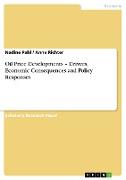Oil Price Developments ¿ Drivers, Economic Consequences and Policy Responses
BücherAngebote / Angebote:
Research Paper (undergraduate) from the year 2007 in the subject Business economics - Economic Policy, grade: 1, 0, University of Applied Sciences Berlin, course: General Economics, language: English, abstract: Oil prices are an important determinant of global economic performance. Crude Oil prices ranged between $2.50/bbl and $3.00/bbl from 1948 through the end of the 1960s. As of this day, the price for crude oil is $89.82/bbl. In general, spikes in oil prices are not unusual and are, to some extent, symptomatic of a gradual upward trend in daily oil price volatility. Volatile prices arise from supply and demand that are both highly inelastic in the short run, with the result that even small shocks can have large effects on price. But especially within the last few years, the oil price has continuously increased sharply - and to some extent unexpected. This recent sharp increase in the oil price prompts several questions: Why have oil prices risen? What is the impact on the global economy and on individual countries? How do oil importing countries cope with the higher prices? What are appropriate policy responses to stabilise the economy in face of high oil prices? And last but not least, what role does the Organisation of Petroleum Exporting Countries really play? To begin with, there is no doubt that the recent increase in oil price is mainly demand driven, combined with historically low excess capacity and heightened concerns about supply disruptions. And even without macroeconomic knowledge, everyone is aware that higher oil prices affect the economy as a whole and all its market participants. In the following, this paper analyses in detail the current main oil price drivers, their economic consequences and the possible policy responses - always framed by the volatility and uncertainty that characterise the oil market.
Folgt in ca. 5 Arbeitstagen




